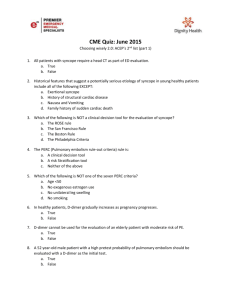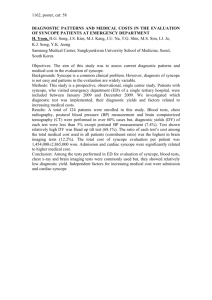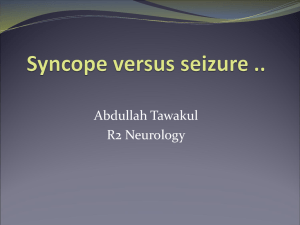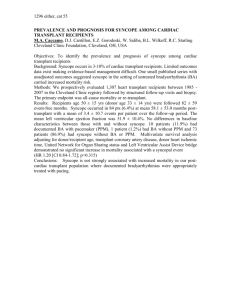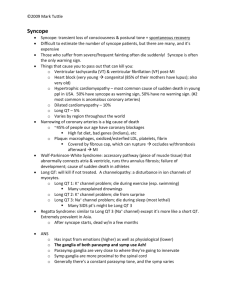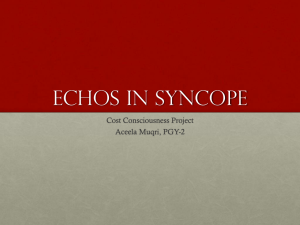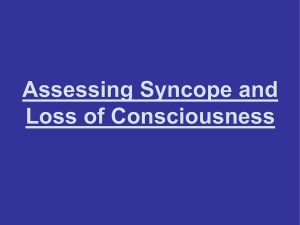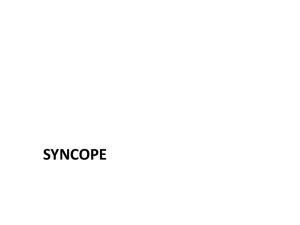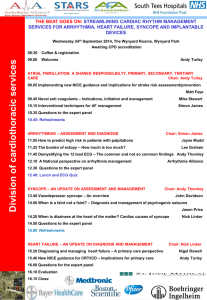Ordering Echocardiograms for Syncope Cost Conscious Project Marvin Chang, PGY2
advertisement
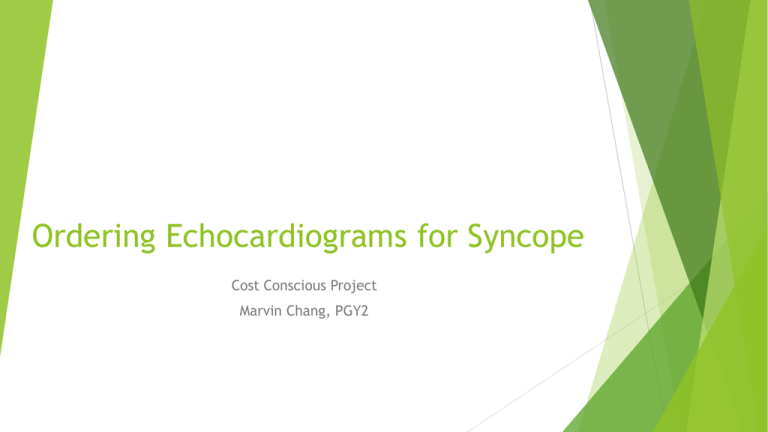
Ordering Echocardiograms for Syncope Cost Conscious Project Marvin Chang, PGY2 Objectives Goal: To identify appropriate indications for ordering echocardiograms in patients admitted for syncope. Estimate the cost saved by judicious ordering of echocardiograms. To promote cost conscious practice of medicine amongst residents. Background Syncope is a sudden and transient loss of consciousness and postural tone. It is followed by complete and usually rapid recovery of neurological function. Often benign and self-limited, but can be a precursor of various significant disease processes. The cumulative incidence of syncope is 3 to 6 percent over 10 years, and 80 percent of patients have their first episode before 30 years of age Classified by the following distribution of etiologies: Reflex (neurally-mediated, including vasovagal) – 58% Cardiac - most often a bradyarrhythmia or tachyarrhythmia, but also structural heart disease – 23% Neurologic or psychiatric illness – 1% Unexplained or unknown – 18% Hypothesis Guidelines advise that routine ordering of echocardiograms for syncope workup is not advised. Hypothesize that a considerable portion of echocardiograms obtained at UCI for syncope are not actually indicated. Initial workup for Syncope EKG for all patients Carotid sinus massage in patients >40 years old Cardiac monitoring when there is a suspicion of arrhythmic syncope Orthostatic challenge when syncope is related to the standing position or there is suspicion of a reflex mechanism. Neurological evaluation or blood tests are less specific but indicated when there is suspicion of non-syncopal transient loss of consciousness that can mimic syncope. Echocardiogram when there is previous known heart disease or data suggestive of structural heart disease or suspect syncope secondary to cardiovascular cause. Indications for Echocardiogram PMH of severe structural or coronary artery disease (heart failure, or previous myocardial infarction) Clinical or EKG features suggesting arrhythmic syncope Syncope during exertion or supine Palpitations at the time of syncope Family history of SCD Non-sustained VT Bifascicular-block (LBBB or RBBB combined with left anterior or left posterior fascicular block) or other intraventricular conduction abnormalities with QRS duration ≥120 ms Inadequate sinus bradycardia (<50 bpm) or sinoartrial block in absence of negative chronotropic medications or physical training Pre-excited QRS complex Prolonged or short QT interval RBBB pattern with ST-elevation in leads V1-V3 (Brugada pattern). Design Study population: All patients admitted to Douglas Hospital inpatient ward teams A-G and family medicine with documented episode of syncope. Exclusion criteria: Patients with presyncope or if unclear whether syncopal episode actually occurred. Study period: 3/23 – 4/3 Review patient’s hospitalization records including admission H&P, laboratory studies, EKG, progress notes and discharge summary. Based on the above, determine if an echocardiogram was indicated for each patient. Then compare to whether an echocardiogram was actually ordered or not. Results A total of 10 patients were hospitalized for syncope between 3/23 – 4/3 6/10 patients had an echocardiogram performed 3/10 patients had indications for echocardiogram: including non sustained VT on telemetry, history of significant CAD s/p CABG, and sensation of palpitations prior to syncopal event. All patients who had indications for echo received one. 3/10 patients had an echo performed that was not indicated. All echocardiograms ordered for syncope during this time period did not have any significant or new findings to adequately explain the syncopal episode. Results Indication for Echo Echo ordered Echo findings Patient #1 Yes – history of significant Yes CAD with CABG No significant or new findings Patient #2 No Yes No significant or new findings Patient #3 No No N/A Patient #4 No Yes No significant or new findings Patient #5 Yes – Palpitations prior to syncopal event Yes No significant or new findings Patient #6 No No N/A Patient #7 Yes – non-sustainted VT recorded on tele Yes No significant or new findings Patient #8 No No N/A Patient #9 No Yes No significant or new findings Patient #10 No No N/A Discussion Average cost of echocardiogram in the US is between $2000-$3000 Appropriately ordering echos can greatly reduce costs and ensure that patients with true indications for echos have them performed and interpreted in a more timely fashion. $6000-$9000 over 14 days ~ $15000 a month ~ 180,000 a year Why are echos over-ordered? Residents are unsure of indications in general. Vasovagal syncope is the most common cause of syncope but also somewhat of a diagnosis of exclusion. Resident inexperience, fear of missing a diagnosis. Pressure to discharge. If an echo is ordered early and the findings are unremarkable it might facilitate discharge. Limitations Small sample size Snapshot of small time interval at UCI douglas hospital At times there was unclear or inadequate documentation to properly determine whether an echo was indicated or not Summary A significant amount of cost can potentially be reduced with prudent ordering of echocardiograms. ED staff should be educated regarding actual definition of syncope and indications for admitting syncope patients, as during the study period there were a number of patients admitted for ‘syncope’ who never actually syncopized. Residents should be educated regarding indications for ordering echocardiograms in syncope Overall, careful thought should be given prior to just routinely ordering echocardiograms for patients admitted for syncope. References Gauer, ‘Evaluation of Syncope’, Am Fam Physician. 2011 Sep 15;84(6):640650. Olshansky, Uptodate.com, ‘Evaluation of syncope in adults’
